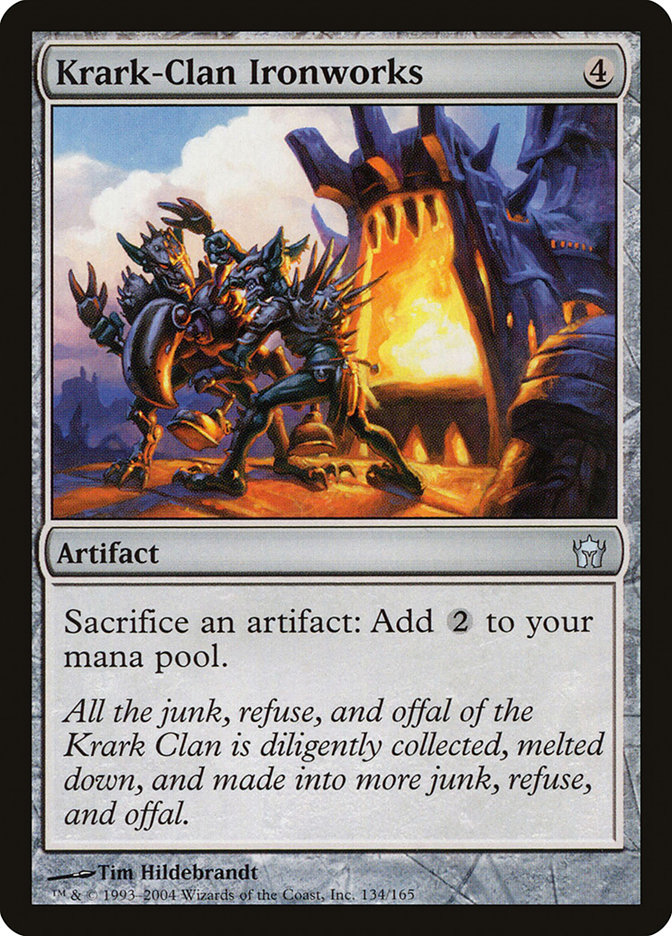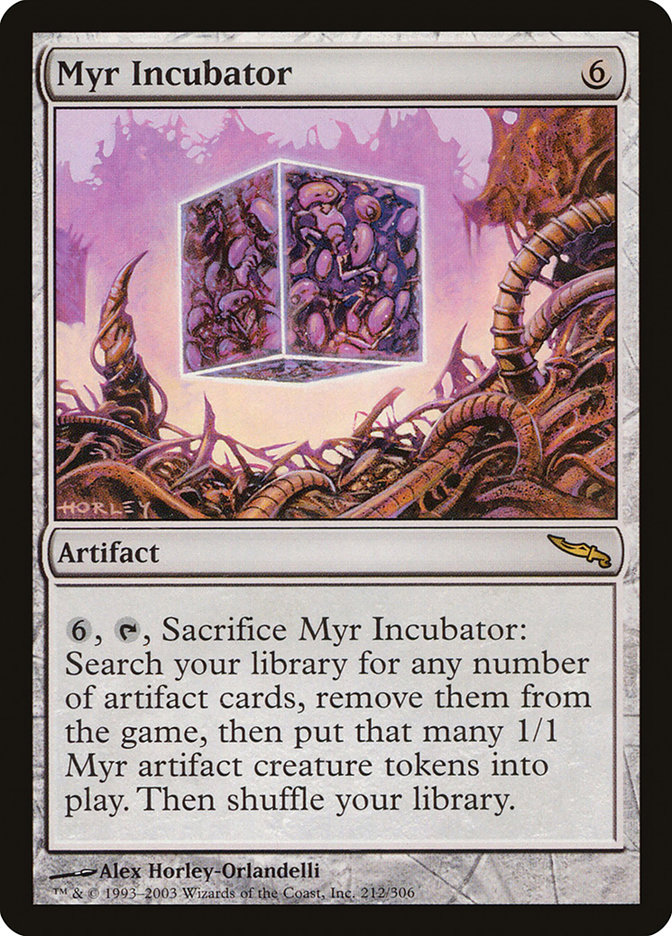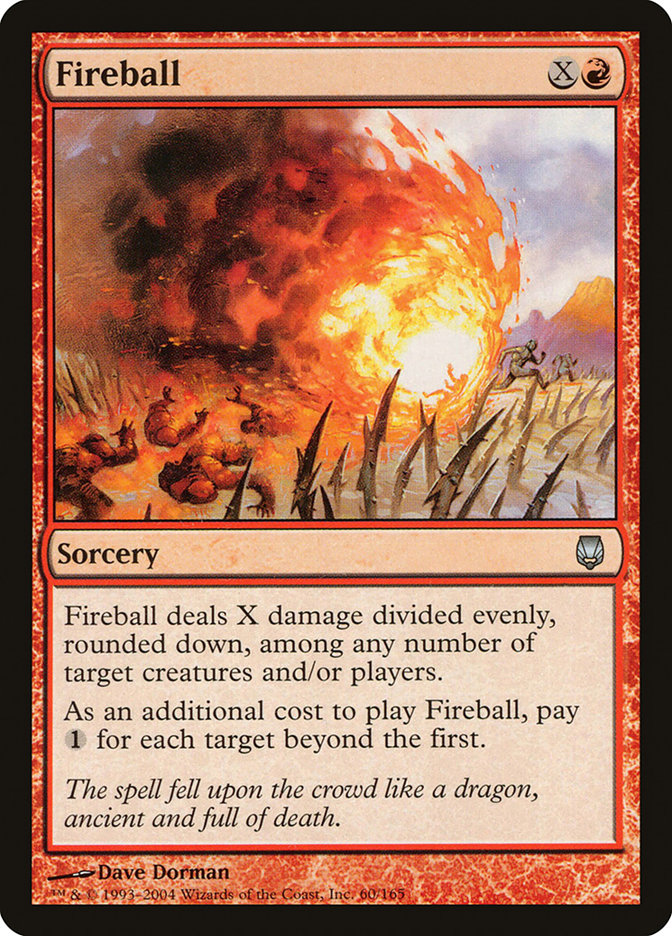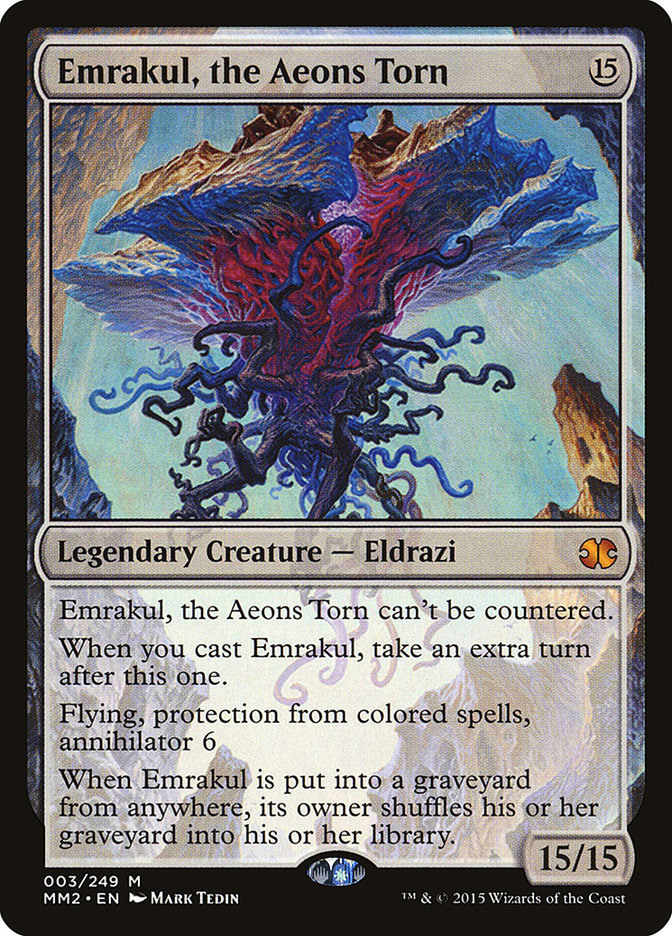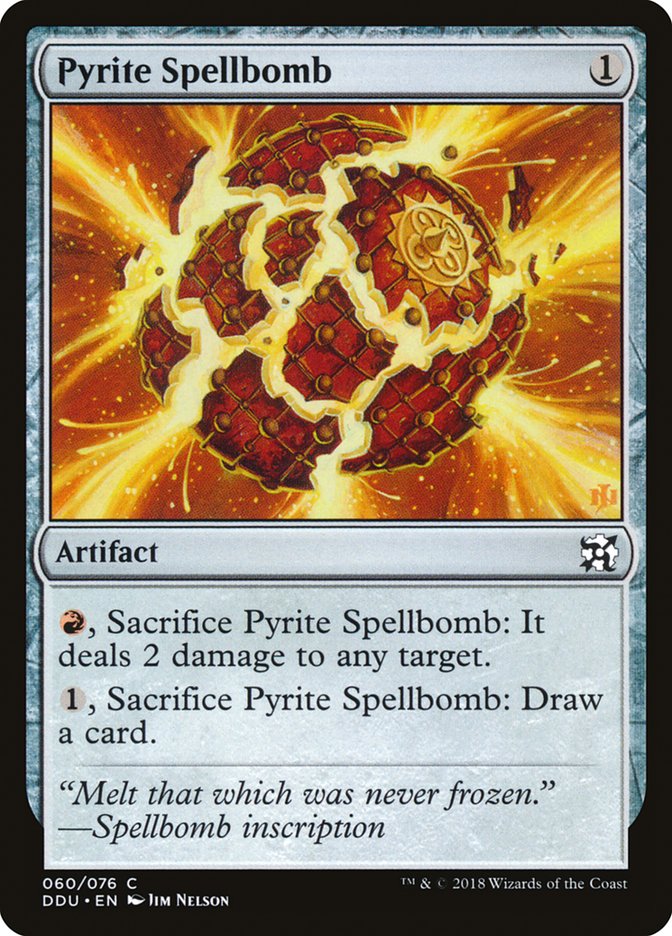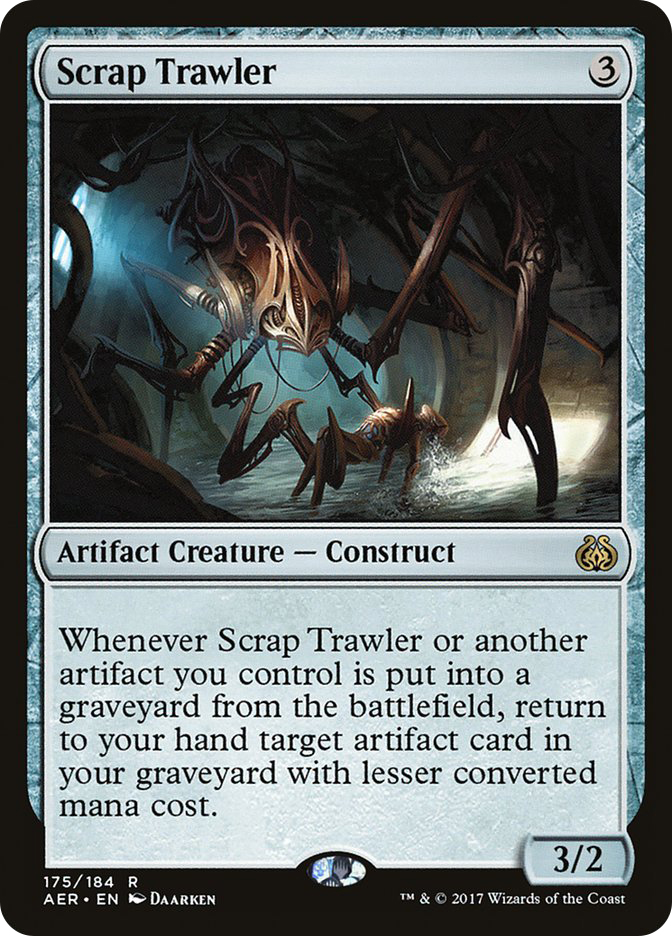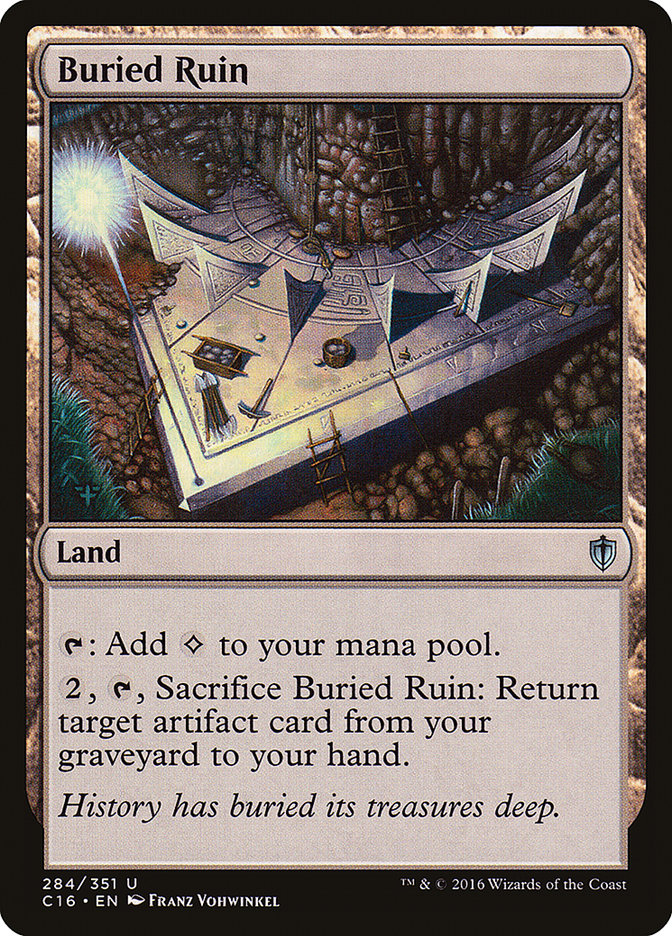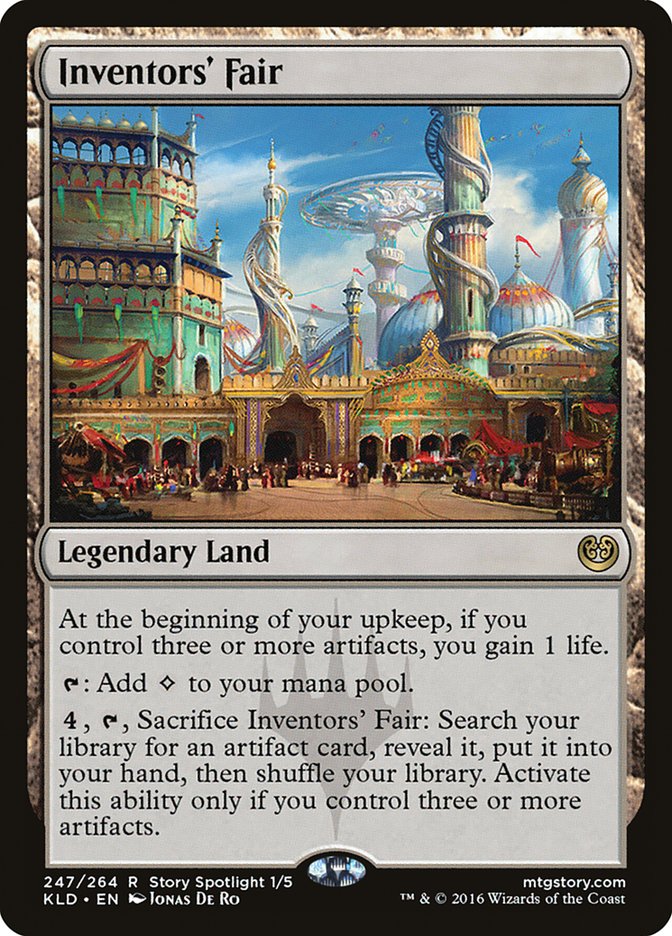I started playing my first Friday Night Magic level decks when Fifth Dawn was printed way back in 2004. The best decks at the
time were, of course, Affinity variants, but I’ve often been compelled to
play something off the beaten path. Back then, I played a wacky deck that
used the artifact lands and Krark-Clan Ironworks to generate twelve mana,
then play and crack a Myr Incubator to create around thirty or so 1/1 Myr
tokens to attack for lethal.
With Fireball in hand, you didn’t even need to attack for the win!
Make no mistake, this Ironworks Combo deck was not the best deck in Mirrodin Block Constructed, and I was handicapping myself in order
to play a deck that I thought was fun and cool. The Ironworks Combo deck I
picked up for Grand Prix Phoenix, however, may well have been the best deck
for that tournament:
Creatures (8)
Lands (18)
Spells (34)

Myself, Samuel Pardee, Matthew Nass, and Andrew Baeckstrom all played
Ironworks Combo at GP Phoenix, with myself, Pardee, and Baeckstrom all
going X-4, and the other, Matt Nass, making the semifinals. Those aren’t
absurd stats, like the opening performance of the grindy Death’s Shadow
decks, but still very good. We started with a list by Shaheen Soorani, and
then improved little things here and there:
- We went up to the full four Mind Stones.
-
We replaced Sanctum of Ugin with
Buried Ruin. -
We added Wurmcoil Engine to the sideboard as a powerful trump
card against Hollow One and Jund.
But mostly, we just decided that the deck was well-positioned for our
expected metagame. We thought most players that like to play fair decks
would gravitate towards Jund over Abzan or Jeskai, which drastically
reduces the number of copies of Stony Silence and Rest in Peace in the
room. Those cards are by far the biggest issue as most other hate cards can
be readily played around. Ironworks Combo is also a very fast, linear combo
deck, which positions it nicely against Tron and means your deck can only
be so bad against anyone.
Before we get into sideboarding, I admit that the deck looks kind of like a
pile of random cards, so first let’s go over what it’s trying to do.
Central Game Plan
The card Krark-Clan Ironworks can generate an enormous amount of mana, and
it’s not uncommon with this deck to make upwards of forty mana in a turn
without technically going infinite. Often it makes so much mana that I just
stop making as much mana as I possibly can because I have more than enough.
After you find a KCI, the goal is either to generate so much mana you can
cast Emrakul, the Aeons Torn or to draw enough cards to assemble an
infinite combo and loop Pyrite Spellbomb enough times to kill your
opponent.
The main two combo pieces are KCI itself and Scrap Trawler. KCI lets you
recycle your dinky artifacts like Ichor Wellspring or Chromatic Star for
mana, while the artifacts themselves cantrip through your deck and find
more artifacts like themselves. Scrap Trawler makes it so that you rarely
run out of more cantrips to sacrifice.
-
Every time you sacrifice a Chromatic Star or a Terrarion, you can
get back a Mox Opal to tap and sacrifice, giving you three more
mana. -
Every time you draw a Mind Stone, you can sacrifice it to cantrip
and get back another Chromatic Star.
With both KCI and Scrap Trawler in play, you can create absurd amounts of
mana and rip through your deck very quickly, and either cast Emrakul or
find a combo.
The main infinite combo in the deck is KCI, Scrap Trawler, Myr Retriever,
Chromatic Star, any any zero mana artifact, and any artifact that costs
three or more mana (namely KCI, Scrap Trawler, or Wurmcoil Engine). The
loop is straightforward, though it takes a number of actions so it can be
confusing when demonstrated for the first time.
Let’s say the battlefield is just KCI, Scrap Trawler, Myr Retriever, with a
KCI, Star, and Engineered Explosives (EE) in the graveyard.
-
Sacrifice the Myr Retriever and get back KCI and Chromatic Star.
(+2 mana) -
Play Chromatic Star, sacrifice for mana and get back EE, sacrifice
for mana. (+5 mana, +1 card) -
Play KCI, sacrifice for mana and get back Myr Retriever and play it
(+1 mana, +1 card)
Now we’re back where we started, with an extra card and an extra mana. Once
you draw a Mox Opal you can make mana without drawing cards, and once you
have infinite red mana you can bring back Pyrite Spellbomb instead of
Chromatic Star and deal damage to the opponent over and over. If you have a
second Scrap Trawler or a Wurmcoil Engine instead of a second KCI, then you
don’t even need the one-drop to make infinite mana (although you might need
it to draw cards!). Once you’re looping, most “lock piece” permanents will
not stop you because you can loop EEs. Cards like Leyline of Sanctity,
Ensnaring Bridge, and Worship aren’t worrisome, and it’s actually a nice
benefit that your interactive spells you have to play (like Echoing Truth
in U/R Gifts Storm) can actually be part of your combo!
While going off, you’re almost always limited by cards rather than mana and
you should play accordingly. For example, sometimes you have a KCI in hand
with two lands, a Mox Opal, a Mind Stone, and another Mox Opal in your
hand. In this case, if you’re trying to go off this turn, I think it’s
almost always correct to legend rule the Mox Opal to make a fourth mana to
play the KCI so you can keep the Mind Stone untapped, and perhaps later on
sacrifice it to draw a card. In this case, you’re losing two mana because
otherwise you could sacrifice the first Mox Opal to the KCI in order to
keep your options open, but I think the trade is always worth it. It’s also
important to keep your land drop open while going off if you can, because
you can draw powerful lands like Buried Ruin or Inventors’ Fair that you
can use to trade mana for cards.
Since most of your cards don’t really do anything, it’s extremely difficult
to win the game without KCI on the battlefield – although I did win a match
with Scrap Trawler beatdown once – so a lot of the deck is built with the
intention of finding it as consistently as possible. When I first saw the
decklist, I was quite doubtful that the deck was any good because it has to
find KCI to win, but it turns out that it’s actually just quite easy to
find them. Ancient Stirrings and Inventors’ Fair both give additional
virtual copies of the powerful artifact and half the deck cantrips. Even
Buried Ruin and Myr Retriever give you some additional redundancy if your
first KCI gets discarded or countered.
Matchups
Sideboarding with linear combo decks is tricky, and you should always err
on the side of sideboarding in fewer cards. With Ironworks Combo in
particular, you need to keep a critical mass of cantripping artifacts in
your deck so you can still draw lots of cards to find a Scrap Trawler while
you’re going off. There are only a small number of cards I’m willing to
sideboard out in any matchup:
- Pyrite Spellbomb and Emrakul, the Aeons Torn
- The second Myr Retriever
- Both Chromatic Spheres
- Both Engineered Explosives
- Hangarback Walker
- Mishra’s Bauble
In general, you want to sideboard in a small number of cards to deal with
the hateful permanents or spells you expect to face.
VS Jund
Out:

In:

They have a lot of dead cards in the first game but you can lose to their
best starts. You have a lot of redundancy against discard spells and can
usually find enough copies of KCI to overpower them. Inventors’ Fair is the
best card in your deck by a long shot, as it’s basically a KCI that cannot
be Thoughtseized. You should always try to play KCI into a battlefield
you’re confident you can win the game from, as they can have Maelstrom
Pulse or Kolaghan’s Command to remove it. Be wary if they pass the turn
with three open mana, because it usually means they have Kolaghan’s
Command.
Chromatic Sphere is the worst cantrip, and you’ll see me taking it out
often. Emrakul is not necessary, as with Wurmcoil Engine in your deck just
making 100 Wurm tokens is normally good enough to beat Jund. I like keeping
in the Pyrite Spellbomb because it can kill Dark Confidant or Scavenging
Ooze on occasion. In this matchup, a ramped out Wurmcoil Engine can often
go the distance, and at the very least it buys you tons of time to find
what you need.
VS Five-Color Humans
Out:

In:

This matchup can be rough as they have a million cheap hateful permanents.
I’ve gotten a lot of mileage out of my opponents not knowing how to play
against my deck or what to name with Meddling Mage, but that may not always
be true. If they draw the wrong half of their deck or you draw Pyrite
Spellbomb, you can win the first game, but it’s not easy.
I’ve debated with sideboarding in the Wurmcoil Engines, but I think they’re
a bit too much of a liability against Reflector Mage. If you think your
opponent doesn’t have any of those, then you should definitely sideboard
them in. In my experience, they usually keep them in to try to pull off
Aether Vial + Reflector Mage to interact with Scrap Trawler.
After sideboard, Ghirapur Aether Grid can be totally insane or it can be
too slow and do nothing. It’s very good against their medium-strength draws
and is a way you can win the game without casting KCI. You really want a
variety of cards to interact with their hateful permanents like Meddling
Mage, Gaddock Teeg, and Thalia, Guardian of Thraben.
VS Burn
Out:

In:

Eidolon of the Great Revel is very good against you and you need to find a
Pyrite Spellbomb or Engineered Explosives to kill it before you can go off.
On average, you’re a faster deck than Burn, and I think the matchup solidly
favors you.
Engineered Explosives is pretty slow against Burn, and Hangarback Walker is
only good against half their draws. They might have Path to Exile after
sideboard, so try to protect Wurmcoil Engine with KCI if you can. Nature’s
Claim and Collective Brutality are powerful answers to Eidolon of the Great
Revel. Don’t forget you can Nature’s Claim your own artifacts to gain life
or specifically on Ichor Wellspring to draw cards. I don’t think their deck
improves much after sideboard, as cards like Destructive Revelry seem good
but ultimately slow down their clock, so I don’t think they’re very
effective. I think Ironworks Combo is more favored after sideboard, as you
gain efficient answers to the scariest card on the other side of the
battlefield.
VS Tron
Out:

In:

Oblivion Stone is the only card in their deck that really matters. They can
conceivably Karn your lands to keep you off KCI, but this matchup is
heavily in your favor. They have very little interaction and cannot kill
you quickly.
Emrakul gets the nod over Pyrite Spellbomb here because sometimes you just
have fifteen mana lying around and if you draw Emrakul it’s nice to just
win the game. Nature’s Claims come in to force Oblivion Stone activations,
kill Relic of Progenitus, and sometimes mise an Expedition Map. Their deck
improves extremely marginally after sideboard and the second verse is the
same as the first.
VS B/R Hollow One
Out:

In:

When their deck does broken things, it’s usually a little bit faster than
you and you lose. When they don’t do broken things, you’re a lot faster
than them and you win. Honestly, there’s not much to say here and neither
of you really interact with the other at all.
Nature’s Claims are necessary to deal with Leyline of the Void, but also
can kill Hollow One as a bonus. Emrakul is unnecessary as Wurmcoli Engines
are good enough and Pyrite Spellbomb can buy you time by killing an early
Flameblade Adept. Not much about the matchup changes after sideboard,
except you get another thing to cry variance about when your opponent
starts with Leyline of the Void on the battlefield.
VS U/R Gifts Storm
Out:

In:

Wow are sideboard guides for linear combo decks really boring. Do your
thing and hope your thing is better than their thing. You can’t really do
anything about Remand if they have it, so you just have to try to play
through it. I think KCI is slightly faster but less consistently than
Storm, and I think combined with Remand makes this an unfavorable matchup.
Nihil Spellbomb serves nicely as a cog you can sacrifice to KCI or a way to
slow down the Storm opponent. This matchup is the reason we played Guttural
Response over more copies of Defense Grids, as you can use it to counter
Gifts Ungiven. Engineered Explosives isn’t great, but I think it deserves
to stay in the deck as you can slow down your opponent considerably if you
proactively play it for two.
VS Affinity
Out:

In:

You are faster on average but less consistent. Honestly I think the die
roll determines who’s a favorite in the first game.
You get far more powerful and effective interaction to slow them down than
they get against you, and Ghirapur Aether Grid can win games
single-handedly. The sideboard should be fairly self-explanatory. I think
you are a solid favorite in the sideboard games.
VS G/W Hexproof
Out:

In:

Jokes on you, Slippery Bogle! I wasn’t planning on killing you anyway!
Although it’s kind of nice that we still can, as maindeck Engineered
Explosives is really powerful against them, you are a big favorite in the
first game as literally none of their cards do anything and their clock is
usually a turn too slow.
The sideboard games are a lot worse, as they have a variety of hateful
permanents, all of which are very strong against you. Stony Silence, Rest
in Peace, and Gaddock Teeg are all permanents that stop you from winning
the game. You need to bring in Collective Brutality to kill Gaddock Teeg
and occasionally you can snipe a Kor Spiritdancer with it. It’ll be
difficult to win any game they draw both a Slippery Bogle/Gladecover Scout
and a hate enchantment, so you have to try to steal a game where they don’t
have both.
Conclusion
If I play another tournament with Ironworks Combo, that’s generally how
I’ll plan to sideboard. If the number of white enchantments like Stony
Silence and Rest in Peace stays low, I think Ironworks Combo will remain a
powerhouse in the Modern metagame. If you want to try picking it up, I
strongly recommend you play solitaire a little bit first so you become
familiar with the mechanics of playing the deck. You have to take a lot of game actions, and it’s very tedious to move dice
tracking mana up and down and up and down and up and down.
Then there’s remembering your triggers and declaring targets for your Scrap
Trawler and explaining loops to your opponents because they lost track of
how much mana you had three minutes ago…
You don’t want to screw up your combo and lose from an unlosable position.
Solitaire also helps you develop an intuition for which game states you’re
likely to be able to go off from, which is very important.
Once you have a good grasp of how to play the deck, then you too will be
able to appreciate the glorious wonder that is Krark-Clan Ironworks – just
like I did all the way back in 2004!


